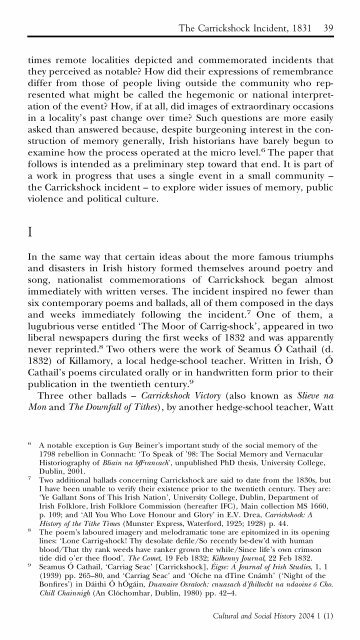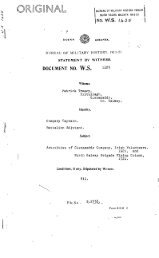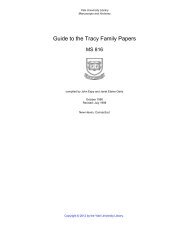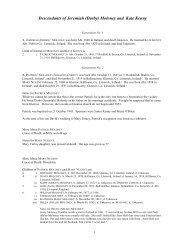The Carrickshock Incident, 1831: Social Memory and an Irish cause ...
The Carrickshock Incident, 1831: Social Memory and an Irish cause ...
The Carrickshock Incident, 1831: Social Memory and an Irish cause ...
You also want an ePaper? Increase the reach of your titles
YUMPU automatically turns print PDFs into web optimized ePapers that Google loves.
<strong>The</strong> <strong>Carrickshock</strong> <strong>Incident</strong>, <strong>1831</strong> 39<br />
times remote localities depicted <strong><strong>an</strong>d</strong> commemorated incidents that<br />
they perceived as notable? How did their expressions of remembr<strong>an</strong>ce<br />
differ from those of people living outside the community who represented<br />
what might be called the hegemonic or national interpretation<br />
of the event? How, if at all, did images of extraordinary occasions<br />
in a locality’s past ch<strong>an</strong>ge over time? Such questions are more easily<br />
asked th<strong>an</strong> <strong>an</strong>swered be<strong>cause</strong>, despite burgeoning interest in the construction<br />
of memory generally, <strong>Irish</strong> histori<strong>an</strong>s have barely begun to<br />
examine how the process operated at the micro level. 6 <strong>The</strong> paper that<br />
follows is intended as a preliminary step toward that end. It is part of<br />
a work in progress that uses a single event in a small community –<br />
the <strong>Carrickshock</strong> incident – to explore wider issues of memory, public<br />
violence <strong><strong>an</strong>d</strong> political culture.<br />
I<br />
In the same way that certain ideas about the more famous triumphs<br />
<strong><strong>an</strong>d</strong> disasters in <strong>Irish</strong> history formed themselves around poetry <strong><strong>an</strong>d</strong><br />
song, nationalist commemorations of <strong>Carrickshock</strong> beg<strong>an</strong> almost<br />
immediately with written verses. <strong>The</strong> incident inspired no fewer th<strong>an</strong><br />
six contemporary poems <strong><strong>an</strong>d</strong> ballads, all of them composed in the days<br />
<strong><strong>an</strong>d</strong> weeks immediately following the incident. 7 One of them, a<br />
lugubrious verse entitled ‘<strong>The</strong> Moor of Carrig-shock’, appeared in two<br />
liberal newspapers during the rst weeks of 1832 <strong><strong>an</strong>d</strong> was apparently<br />
never reprinted. 8 Two others were the work of Seamus Ó Cathail (d.<br />
1832) of Killamory, a local hedge-school teacher. Written in <strong>Irish</strong>, Ó<br />
Cathail’s poems circulated orally or in h<strong><strong>an</strong>d</strong>written form prior to their<br />
publication in the twentieth century. 9<br />
Three other ballads – <strong>Carrickshock</strong> Victory (also known as Slieve na<br />
Mon <strong><strong>an</strong>d</strong> <strong>The</strong> Downfall of Tithes), by <strong>an</strong>other hedge-school teacher, Watt<br />
6 A notable exception is Guy Beiner’s import<strong>an</strong>t study of the social memory of the<br />
1798 rebellion in Connacht: ‘To Speak of ’98: <strong>The</strong> <strong>Social</strong> <strong>Memory</strong> <strong><strong>an</strong>d</strong> Vernacular<br />
Historiography of Bliain na bfFr<strong>an</strong>cach’, unpublished PhD thesis, University College,<br />
Dublin, 2001.<br />
7 Two additional ballads concerning <strong>Carrickshock</strong> are said to date from the 1830s, but<br />
I have been unable to verify their existence prior to the twentieth century. <strong>The</strong>y are:<br />
‘Ye Gall<strong>an</strong>t Sons of This <strong>Irish</strong> Nation’, University College, Dublin, Department of<br />
<strong>Irish</strong> Folklore, <strong>Irish</strong> Folklore Commission (hereafter IFC), Main collection MS 1660,<br />
p. 109; <strong><strong>an</strong>d</strong> ‘All You Who Love Honour <strong><strong>an</strong>d</strong> Glory’ in E.V. Drea, <strong>Carrickshock</strong>: A<br />
History of the Tithe Times (Munster Express, Waterford, 1925; 1928) p. 44.<br />
8 <strong>The</strong> poem’s laboured imagery <strong><strong>an</strong>d</strong> melodramatic tone are epitomized in its opening<br />
lines: ‘Lone Carrig-shock! Thy desolate de le/So recently be-dew’d with hum<strong>an</strong><br />
blood/That thy r<strong>an</strong>k weeds have r<strong>an</strong>ker grown the while/Since life’s own crimson<br />
tide did o’er thee ood’. <strong>The</strong> Comet, 19 Feb 1832; Kilkenny Journal, 22 Feb 1832.<br />
9 Seamus Ó Cathail, ‘Carriag Seac’ [<strong>Carrickshock</strong>], Éigse: A Journal of <strong>Irish</strong> Studies, 1, 1<br />
(1939) pp. 265–80, <strong><strong>an</strong>d</strong> ‘Carriag Seac’ <strong><strong>an</strong>d</strong> ‘O/´che na dTine Cnámh’ (‘Night of the<br />
Bon res’) in Dáithi Ó hÓgáin, Du<strong>an</strong>aire Osra/´och: cnuasach d’fhil/´ocht na ndaoine ó Cho.<br />
Chill Chainnigh (An Clóchomhar, Dublin, 1980) pp. 42–4.<br />
Cultural <strong><strong>an</strong>d</strong> <strong>Social</strong> History 2004 1 (1)
















